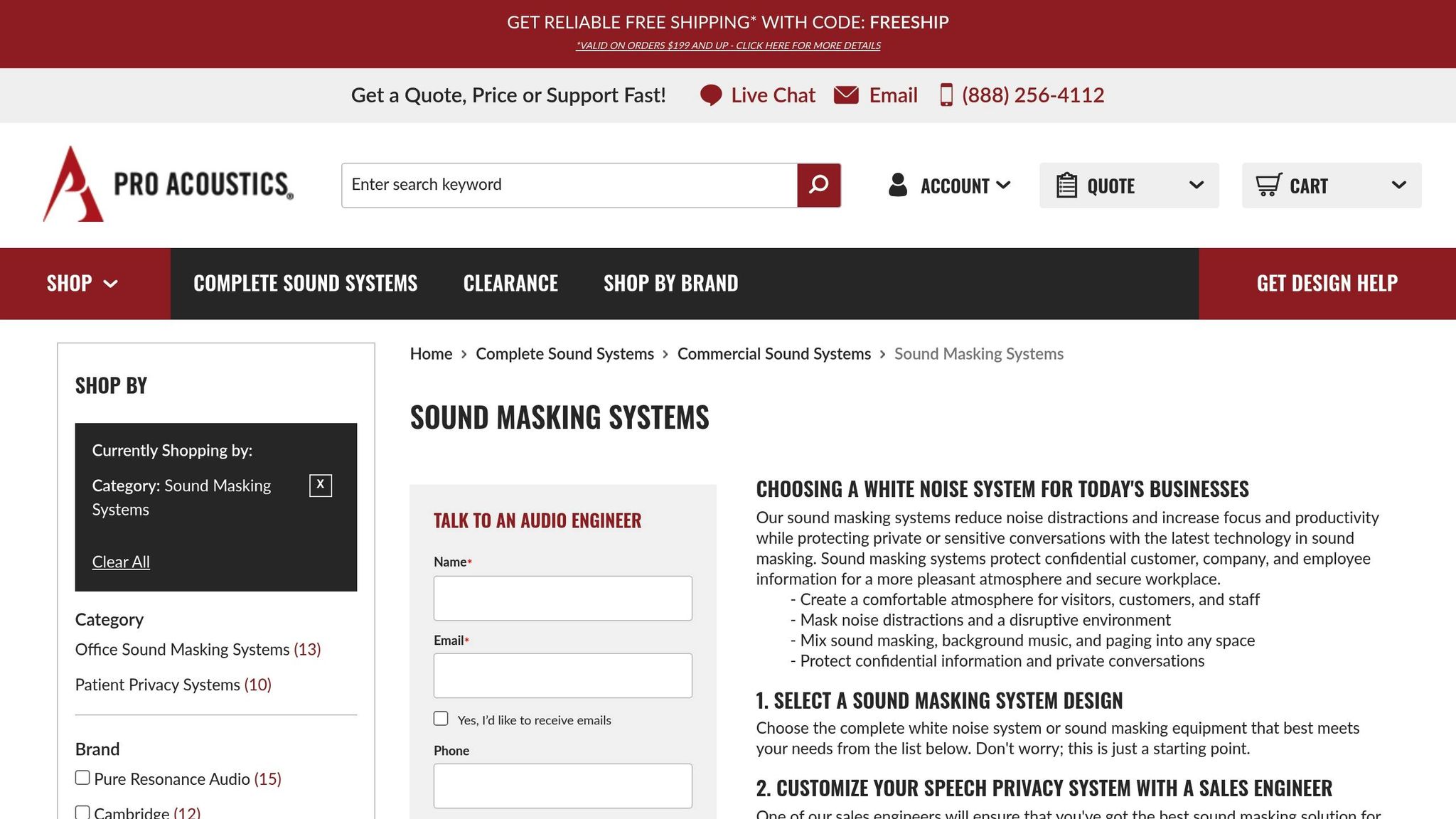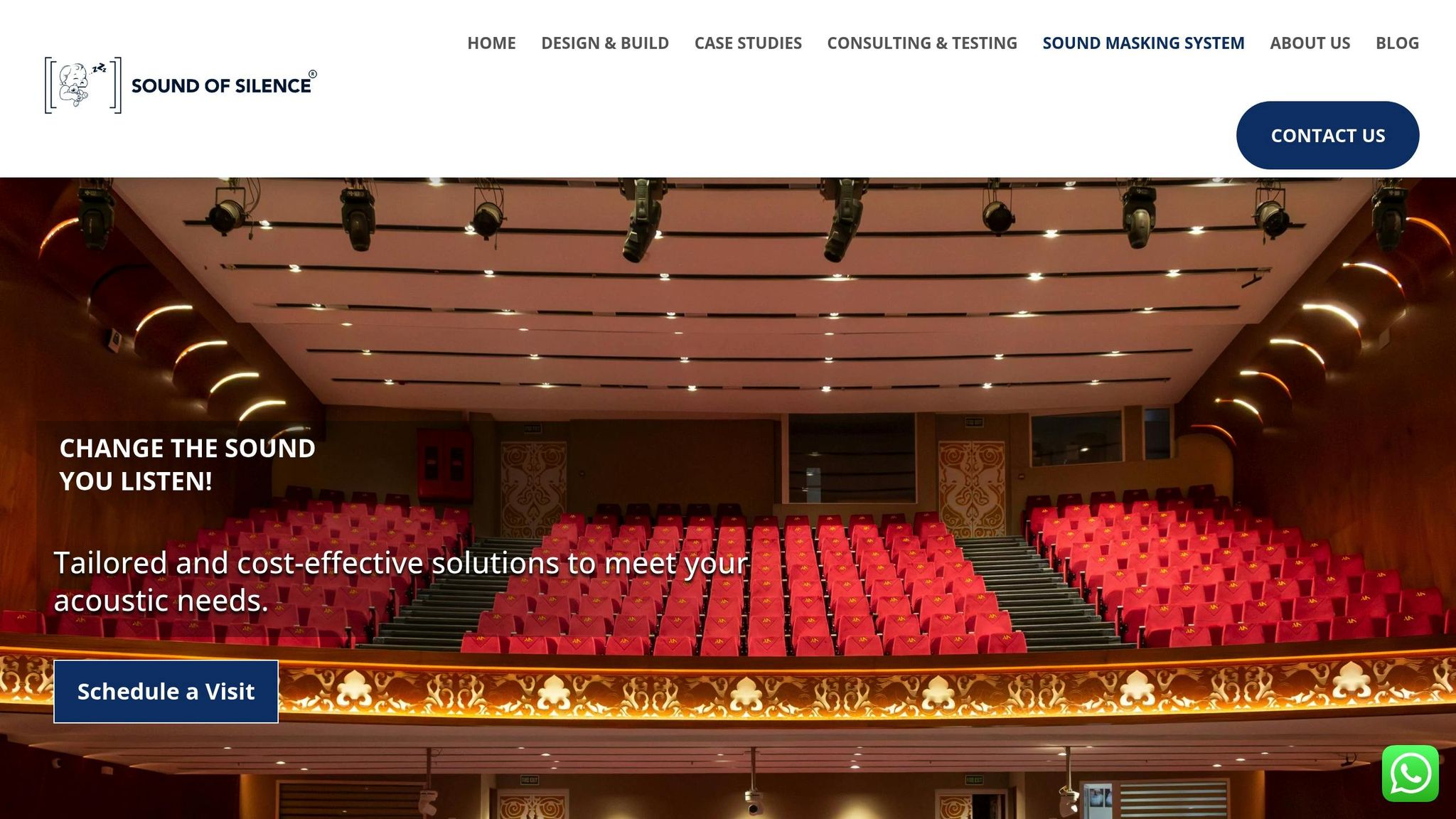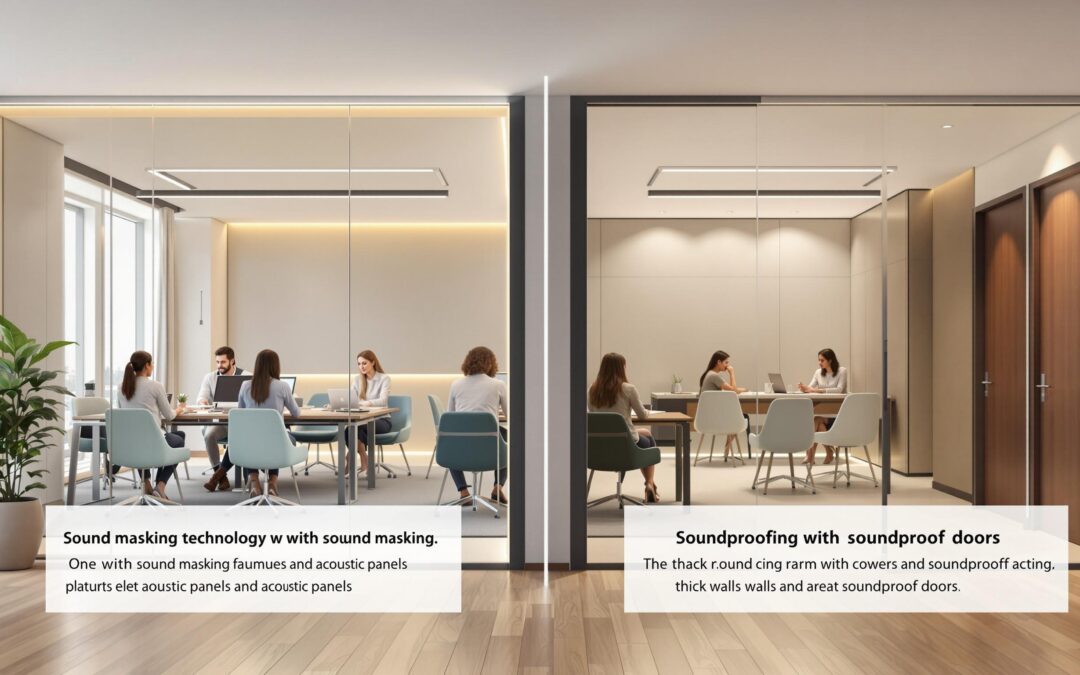Sound masking and soundproofing are two distinct methods for managing noise in spaces. Here’s a quick breakdown:
- Sound Masking: Adds controlled background noise to reduce distractions and improve privacy in open areas like offices.
- Soundproofing: Blocks sound from travelling between spaces using physical barriers, ideal for recording studios or cinemas.
Quick Comparison:
| Feature | Sound Masking | Soundproofing |
|---|---|---|
| Primary Function | Reduces speech clarity | Blocks sound transmission |
| Best Applications | Open-plan offices | Recording studios, cinemas |
| Sound Reduction Method | Adds background noise | Uses physical barriers |
| Ideal Environment | Spaces where silence isn’t essential | Spaces needing total sound isolation |
For the best results, consider combining both methods to balance privacy and openness in shared spaces.
Sound Absorption vs Sound Masking on Pro Acoustics Tech …

Sound Masking and Soundproofing Basics
Let’s break down the key ideas behind these two methods.
What Is Sound Masking?
Sound masking involves adding a consistent background noise to make speech and other sounds less noticeable. Essentially, it raises the overall noise level in a space, making conversations harder to overhear from a distance. This technique is commonly used in offices or other settings where privacy and reducing distractions are priorities.
What Is Soundproofing?
Soundproofing, on the other hand, focuses on stopping sound from travelling between spaces. It uses specific materials and construction techniques to block or absorb noise. By treating walls, floors, and ceilings, soundproofing helps minimise noise from both inside and outside sources, creating a quieter and more comfortable environment.
Next, we’ll explore how these methods differ and where they’re best applied.
Main Differences: Sound Masking vs Soundproofing
How Each Method Works
Sound masking involves adding ambient noise to make speech less understandable, while soundproofing relies on physical barriers to prevent sound from travelling between spaces.
Where to Use Each Method
Sound masking is ideal for open-plan offices to improve speech privacy. Soundproofing, on the other hand, is better suited for environments like recording studios or cinemas where complete acoustic isolation is needed.
Side-by-Side Comparison
| Feature | Sound Masking | Soundproofing |
|---|---|---|
| Primary Function | Reduces speech clarity | Blocks sound transmission |
| Best Applications | Open-plan offices | Recording studios, cinemas |
| Sound Reduction Method | Adds background noise | Uses physical barriers |
| Ideal Environment | Spaces where silence isn’t essential | Spaces needing total sound isolation |
Consider the specific noise issues and requirements of your space. In many cases, combining both approaches can deliver the best results.
Next, we’ll look at how these methods perform in open-plan offices.
sbb-itb-06ab728
Open Office Solutions
Let’s take a closer look at how different acoustic methods perform in open-plan office environments.
Sound Masking Results
Sound masking adds a controlled background noise to the office environment. This helps to cover up nearby conversations, making them less distracting, improving privacy, and maintaining focus. It works well in open spaces with minimal physical barriers, as the ambient sound blends naturally into the background.
Soundproofing Results
Soundproofing creates quiet areas for private meetings, phone calls, or focused tasks by blocking sound transmission. This is often achieved through enclosed booths or rooms. Combining these soundproofed spaces with sound masking ensures the office remains open while still offering areas with necessary acoustic isolation.
Effective open-plan office designs use a mix of both approaches. Sound masking provides a comfortable acoustic base, while soundproofed zones offer quiet spaces for more private or intensive work. Together, they create a balanced and functional workspace.
Picking the Best Solution
Assessing Noise Issues
Determine if your primary concern is noise travelling between spaces or general distractions. A clear understanding will help you pick the right approach.
- Noise transmission involves sounds passing through walls, external disturbances, overheard conversations, or equipment noise.
- Distraction comes from nearby chatter, the general hum of the office, or activity in shared spaces.
For precise identification of the problem, professional acoustic testing can be invaluable.
Combining Approaches
In large open-plan offices where both privacy and collaboration are essential, using sound masking alongside soundproofing can be highly effective. Professional acoustic testing can guide proper implementation, ensuring the workspace remains balanced and functional.
Professional Acoustic Services
To turn your acoustic plans into reality, rely on professional services for accurate assessments and customised solutions.
Sound of Silence Solutions

Once you’ve identified noise concerns and chosen a strategy, expert services can help achieve the best results. Sound of Silence provides a range of acoustic services, such as:
- Detailed analysis and design, including acoustic performance modelling
- Sound and vibration testing, measuring sound levels, reverberation times, and transmission paths
- Installation of systems, including sound masking and soundproofing, all in line with UK building regulations
Their expertise spans commercial, residential, and industrial spaces. From open-plan offices and heritage sites to cinemas and recording studios, they ensure each solution fits the functional needs while maintaining the space’s unique character.
Why Professional Implementation Matters
Using professional services brings clear advantages:
- Access to expertise for identifying noise sources and achieving reliable results through testing, advice, and execution
- Guidance on balancing sound masking and soundproofing, ensuring open offices and private spaces work together effectively
Conclusion
Sound masking and soundproofing address different noise issues. Masking introduces controlled background noise to reduce the clarity of conversations in open-plan offices, while soundproofing physically blocks sound from travelling between spaces.
Use masking to limit overheard conversations. Choose soundproofing when you need complete acoustic isolation – or combine the two for a more comprehensive approach.
Sound of Silence offers complete services, from consulting and testing to installation, creating masking, soundproofing, or hybrid solutions tailored to your specific needs.

